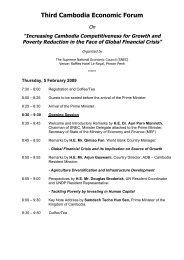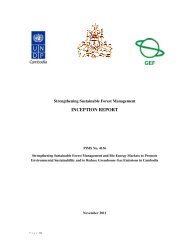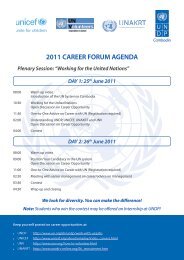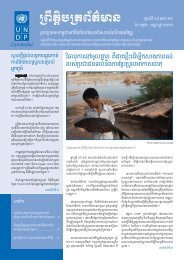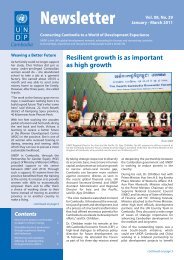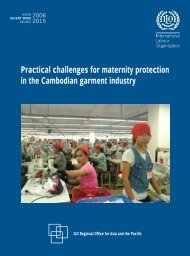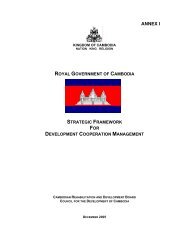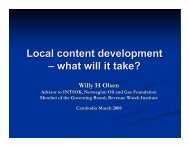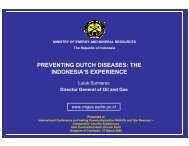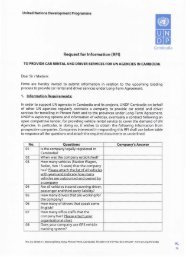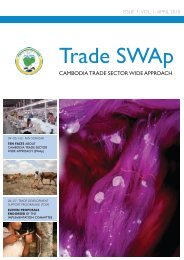UN Analysis Final.pdf - United Nations in Cambodia
UN Analysis Final.pdf - United Nations in Cambodia
UN Analysis Final.pdf - United Nations in Cambodia
You also want an ePaper? Increase the reach of your titles
YUMPU automatically turns print PDFs into web optimized ePapers that Google loves.
Young couples enter<strong>in</strong>g marriage, especially young married women and couples liv<strong>in</strong>g <strong>in</strong> rural and remote<br />
areas, were found to be at high risk because they have to face issues of landlessness and land atomisation 28<br />
(Fitzgerald and So 2007), as well as f<strong>in</strong>ancial shortfall <strong>in</strong> their new families, illnesses among family members,<br />
and limited skills. Most young married couples are expected to participate <strong>in</strong> the family’s agriculture-based<br />
production, which is often not profitable. Young married women beg<strong>in</strong> to be burdened with <strong>in</strong>creased<br />
household responsibility, and with problems related to the poor health and nutrition that they have<br />
experienced <strong>in</strong> their adolescent years, which are compounded by early child bear<strong>in</strong>g that follows early<br />
marriage and, an <strong>in</strong>adequate food supply and limited <strong>in</strong>come. These factors account for young married<br />
women hav<strong>in</strong>g difficult pregnancies and the high risk of maternal and child mortality and morbidity<br />
(Moore 2007), and also expla<strong>in</strong> why young married women are more vulnerable than unmarried women <strong>in</strong><br />
the same age group.<br />
Young people <strong>in</strong> the village either married or unmarried, who cannot f<strong>in</strong>d enough money to support their<br />
family and who lack jobs to do <strong>in</strong> the village especially after grow<strong>in</strong>g paddy rice or sometimes after harvest,<br />
move out of the village to Phnom Penh or Kampong Som. Some go to Neak Loeung (<strong>in</strong> Prey Veng). People<br />
<strong>in</strong> this village mostly depend on rice-fields and crops so that <strong>in</strong> general, young people leave the village to<br />
f<strong>in</strong>d jobs such as sell<strong>in</strong>g newspapers, work<strong>in</strong>g for private households, or becom<strong>in</strong>g construction workers,<br />
garment workers or motodop drivers... – FGD parents’ group, Sangker Village, Svay Rieng Commune<br />
Rural households often accumulate long-term debts due to their <strong>in</strong>ability to repay them. Unpaid <strong>in</strong>terest soars<br />
from month to month for long periods, such as from one to two years, br<strong>in</strong>g<strong>in</strong>g extreme hardship to families.<br />
The first family members to suffer from this situation are youths, s<strong>in</strong>ce parents usually pull them out of school<br />
and send them to work with moneylenders to reduce the family debt, or to work <strong>in</strong> other families to earn<br />
additional <strong>in</strong>come. Issues related to their deployment <strong>in</strong>to such work (child traffick<strong>in</strong>g, violence, and sexual<br />
exploitation and abuse at the hands of employers) can arise and <strong>in</strong>crease their vulnerability.<br />
Most young people <strong>in</strong> rural areas who live <strong>in</strong> large households are more likely to be poor and vulnerable<br />
than those liv<strong>in</strong>g <strong>in</strong> smaller households. The World Bank (2006) characterized poor and vulnerable<br />
households as those hav<strong>in</strong>g many small children but lack<strong>in</strong>g <strong>in</strong> adult wage earners. A high proportion of<br />
children and adolescents implies a high dependency ratio, which generally has a depress<strong>in</strong>g effect on per<br />
capita <strong>in</strong>come. In rural areas, where most of the poor are located, the dependency ratio rises to 89.6 per cent<br />
compared with 69.1 per cent <strong>in</strong> urban areas. A dependency ratio also changes accord<strong>in</strong>g to the number<br />
of elderly or disabled people unable to work (World Bank 2006).<br />
7.2.2 YOUTH VULNERABILITY AND PHYSICAL AND MENTAL HEALTH CHALLENGES<br />
Street or homeless youth are considered the most vulnerable group <strong>in</strong> <strong>Cambodia</strong>, and are categorized<br />
<strong>in</strong>to three types: primary homeless or roofless; secondary homeless (stay<strong>in</strong>g <strong>in</strong> any form of temporary<br />
accommodation, with no secure hous<strong>in</strong>g elsewhere); and tertiary homeless (long-term occupants of<br />
s<strong>in</strong>gle rooms <strong>in</strong> private board<strong>in</strong>g houses) (Chamberla<strong>in</strong> and MacKenzie 1992). Young homeless people are<br />
particularly at risk of a wide range of physical and mental health problems, a lack of access to basic needs<br />
such as food and cloth<strong>in</strong>g, and a multitude of dangers, <strong>in</strong>clud<strong>in</strong>g sexual exploitation and violence. Youth<br />
can also face problems stemm<strong>in</strong>g from overcrowded, unsafe, unhygienic hous<strong>in</strong>g, as well as <strong>in</strong>secure tenure<br />
28<br />
Land atomisation is the division of land <strong>in</strong>to smaller parcels so that all children of a household<br />
may benefit from the ownership of a small piece of land.<br />
Situation <strong>Analysis</strong> of Youth <strong>in</strong> <strong>Cambodia</strong><br />
83




